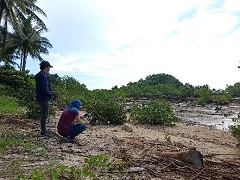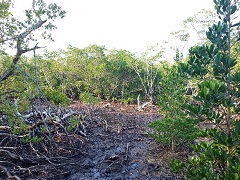- Home
- Countries & Regions
- Asia
- Philippines
- Press Release
- JICA study on blue carbon ecosystems zeroes in on mangroves' role in disaster resilience in the Philippines
Press Release
July 16, 2019
JICA study on blue carbon ecosystems zeroes in on mangroves' role in disaster resilience in the Philippines
Japanese and Filipino scientists are studying the characteristics of the mangroves that survived Typhoon Yolanda in Eastern Samar, saying it may help unlock findings that could help boost disaster resilience of coastal areas and enhance marine conservation in the Philippines.
The activity is part of an ongoing JICA-assisted project called Comprehensive Assessment and Conservation of Blue Carbon Ecosystems and their Services in the Coral Triangle, also known as BlueCARES, meant to identify the dynamics of the blue carbon or carbon dioxide stored in marine ecosystems in the Coral Triangle. The Coral Triangle, the global center of marine diversity, is composed of the following countries: Philippines, Indonesia, Malaysia, Papua New Guinea, Timor Leste, and Solomon Islands. When the blue carbon system is damaged, an enormous amount of carbon is released to the atmosphere, adversely contributing to climate change.
 Study team utilizing a drone to capture images of mangroves
Study team utilizing a drone to capture images of mangroves
In the Philippines, the project sites include Palawan, Aklan, and Eastern Samar. The team surveyed and mapped mangroves using drones along the coasts of Hernani and Balangkayan in Eastern Samar. In Balangkayan, mangroves were profiled, while soil and water samples were collected for carbon content analysis. Said samples will be used to study the vulnerability of mangroves against natural disasters. "The results of the survey will help the team prepare recommendations on disaster management in coastal communities," said JICA Philippines Senior Representative Yo Ebisawa.
JICA has been working with academic institutions to come up with research to address global issues in the environment, disaster management, and health among others under its Science and Technology Research Partnership for Sustainable Development or SATREPS. The project is the first tripartite cooperation among Tokyo Institute of Technology, University of the Philippines Diliman, and Ministry of Marine Affairs and Fishery in Indonesia. In the Philippines, said project is also establishing a "core and network" system through partnerships with academe, local government units, and government organizations for nationwide monitoring and implementation of blue carbon strategy along with capacity building.
The study team aims to help guide decisions of nations with rich biodiversity when it comes to battling against climate change. BlueCARES study began in 2017 and will end in 2022. Already, the project team completed initial surveys in Busuanga and in Panay Island, and mapping of mangroves and seagrasses in Eastern Samar.
"Results of the survey in Eastern Samar will contribute in producing maps of mangroves in the Philippines, and studying their dynamics in the context of disaster management. The surveys are also important in formulating a blue carbon strategy in the country," said Dr. Kazuo Nadaoka, BlueCARES Chief Technical Advisor.
 Mangroves offer communities protection against strong waves and storm surges
Mangroves offer communities protection against strong waves and storm surges
In the aftermath of Typhoon Yolanda in 2013, it was reported that there were families in Eastern Samar that survived because of the mangroves that protected their area. Other studies show that the Philippines has about 50% of the total mangrove species in the world. Mangroves are also among the carbon-rich forests providing protection against strong waves and storm surges. Studying the mangroves that survived Typhoon Yolanda is therefore crucial in the study of blue carbon system conservation.
"The project takes a long-range vision of hopefully contributing to a framework on blue carbon ecosystem conservation that is based on scientific evidence, and also identify conservation strategies at the local level," added Ebisawa.
In the Philippines, JICA has been helping advance science-based policies in conservation of areas like Boracay, Puerto Galera, and Bolinao and enhanced earthquake and volcano monitoring under SATREPS.

- Asia
- Southeast Asia
- Cambodia
- Indonesia
- Laos
- Malaysia
- Myanmar
- Philippines
- Thailand
- Timor-Leste
- Viet Nam
- East Asia
- China
- Mongolia
- Central Asia and the Caucasus
- Armenia
- Azerbaijan
- Georgia
- Kyrgyz Republic
- Tajikistan
- Uzbekistan
- South Asia
- Afghanistan
- Bangladesh
- Bhutan
- India
- Maldives
- Nepal
- Pakistan
- Sri Lanka
- Oceania
- Latin America
- Africa
- Middle East
- Europe
- Asia
- About JICA
- News & Features
- Countries & Regions
- Our Work
- Thematic Issues
- Types of Assistance
- Partnerships with Other Development Partners
- Climate Change / Environmental and Social Considerations
- Evaluations
- Compliance and Anti-corruption
- Science and Technology Cooperation on Global Issues
- Research
- JICA Development Studies Program / JICA Chair
- Support for the Acceptance of Foreign HRs / Multicultural and Inclusive Community
- Publications
- Investor Relations
